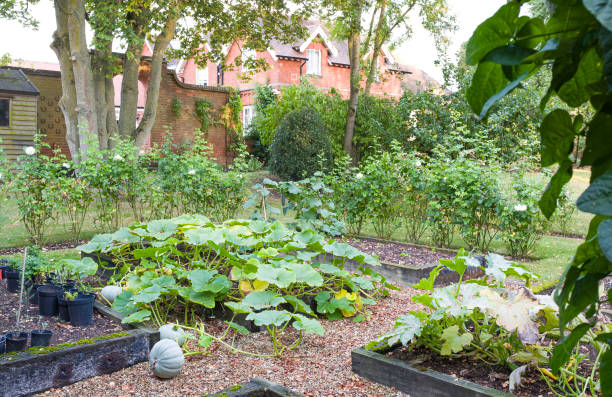A home garden is more than just an outdoor space filled with plants; it’s a personal retreat, a place to nurture and grow both flora and a sense of connection with nature. Over the years, home gardens have become increasingly popular as people seek to enhance their surroundings, grow their own food, and contribute to a more sustainable lifestyle. In this article, we will explore the benefits, types, and essential elements of home gardens, and provide guidance on how to create and maintain a thriving garden in your own backyard, no matter the size.
The Benefits of a Home Garden
The decision to cultivate a home garden can transform not only your living space but also your health and well-being. Here are some of the most significant benefits of having a home garden:
1- Health and Wellness
Gardening is a great form of physical activity that engages the entire body. Digging, planting, watering, and weeding all involve movement that can improve physical fitness, increase strength, and reduce the risk of chronic illnesses. Spending time in the garden has also been shown to reduce stress levels, boost mental clarity, and promote relaxation. The tactile interaction with soil, plants, and nature has therapeutic effects and can improve mood and reduce anxiety.
2- Fresh, Organic Produce
One of the most rewarding aspects of home gardening is the ability to grow your own fruits, vegetables, and herbs. This allows you to have control over how your food is grown—whether it’s pesticide-free, organic, or heirloom varieties. Nothing compares to the taste of freshly picked produce, and growing your own food can reduce grocery costs while ensuring that you have access to fresh, healthy ingredients year-round.
3- Environmental Impact
Home gardens contribute positively to the environment in a number of ways. They promote biodiversity by providing a habitat for birds, insects, and other wildlife. They also reduce the carbon footprint associated with food production and transportation by allowing you to grow food locally. Gardening also improves air quality and helps manage stormwater by reducing runoff. Additionally, by practicing composting, you can recycle organic waste and reduce landfill use, enriching your garden’s soil in the process.
4- Aesthetic Appeal and Property Value
A well-maintained garden enhances the beauty of your home, adding color, texture, and visual interest. Whether it’s a lush lawn, vibrant flower beds, or neatly trimmed hedges, gardens can significantly boost curb appeal. In many cases, a beautiful garden can increase property value, making it a sound investment. Additionally, outdoor spaces that are aesthetically pleasing encourage more time spent outdoors, enjoying nature and fresh air.
Types of Home Gardens
There are many different types of home gardens, each offering its own unique benefits and catering to different gardening goals. Here are some of the most popular types of home gardens:
1- Vegetable Gardens
A vegetable garden is one of the most productive types of home gardens, providing fresh, seasonal produce directly from your yard. These gardens can be as large or small as your space allows. Raised beds are a common choice for vegetable gardening because they provide good drainage and make it easier to control soil quality. Common vegetables to grow include tomatoes, peppers, carrots, spinach, lettuce, and cucumbers. You can also integrate herbs like basil, parsley, and cilantro into your vegetable garden to enhance its diversity and utility.
2- Herb Gardens
Herb gardens are compact and can be easily integrated into any part of your yard or even indoors. They are perfect for those who love to cook with fresh ingredients. Common herbs grown in home gardens include rosemary, thyme, mint, oregano, and sage. You can plant herbs in raised beds, containers, or window boxes, making them highly adaptable to small spaces.
3- Flower Gardens
Flower gardens add color, fragrance, and beauty to your home. They can be designed for year-round interest by choosing a mix of annuals and perennials that bloom in different seasons. Common flower garden designs include butterfly gardens (designed to attract pollinators), rock gardens, and cutting gardens (where flowers are grown specifically to be cut and used in arrangements). Popular flowers for home gardens include roses, marigolds, petunias, lavender, and hydrangeas.
4- Indoor Gardens
Indoor gardens allow people to enjoy the benefits of gardening even if they don’t have an outdoor space. Indoor plants can help purify the air, reduce stress, and brighten living spaces. Common indoor plants include succulents, ferns, spider plants, and pothos. For those interested in growing food indoors, options like microgreens, lettuce, and herbs can be grown on sunny windowsills or under grow lights.
5- Vertical Gardens
Vertical gardening is a great option for those with limited space, particularly in urban environments. This type of garden maximizes growing space by using walls, trellises, or hanging containers to grow plants vertically. Vertical gardens are ideal for growing vining plants such as tomatoes, cucumbers, beans, and even strawberries. Herbs and flowers can also be grown in vertical spaces.
6- Wildlife Gardens
Wildlife gardens are designed to attract and support local wildlife, particularly pollinators like bees, butterflies, and birds. By planting native species, adding bird feeders, and providing water sources, you can create a garden that supports biodiversity. Wildlife gardens often include nectar-rich flowers, berry-producing shrubs, and grasses that provide shelter and food for animals.
Creating a Home Garden
No matter what type of garden you decide to create, the process of planning, designing, and planting is essential for success. Below is a step-by-step guide to help you create your ideal home garden:
1- Assess Your Space
The first step in creating a garden is to assess the available space. Consider factors such as sunlight, soil type, wind exposure, and drainage. Understanding these conditions will help you select the right plants for your garden. For example, most vegetables require full sun (at least six hours of direct sunlight), while certain shade-loving flowers, like hostas or ferns, can thrive in less sunny areas.
2- Plan Your Garden Design
Once you have assessed your space, sketch out a garden design. This can be as simple or complex as you’d like. Consider the placement of beds, walkways, and any other elements like fences, trellises, or seating areas. If you’re growing vegetables, you may want to group plants with similar water and sunlight needs together. For flower gardens, think about layering plants by height to create depth and ensure that all plants are visible.
3- Prepare the Soil
Healthy soil is the foundation of any successful garden. Most plants prefer well-draining, nutrient-rich soil. You can improve your garden’s soil by adding organic matter like compost, which improves structure and provides essential nutrients. It’s also a good idea to test your soil’s pH to determine if it needs any amendments.
4- Select Your Plants
Choose plants that are well-suited to your climate and the conditions in your garden. For vegetable gardens, select crops that are appropriate for the season (cool-season crops like lettuce and peas in spring and fall, and warm-season crops like tomatoes and peppers in summer). For flower gardens, consider choosing a mix of annuals and perennials for continuous blooms. Native plants are often a good choice because they are adapted to the local environment and require less maintenance.
5- Planting
Once you’ve chosen your plants, it’s time to start planting. Follow the specific planting instructions for each plant, paying attention to spacing, depth, and watering needs. After planting, water thoroughly to help the plants establish their roots.
Maintaining Your Home Garden
After the initial planting, regular maintenance is crucial to ensure your garden thrives. Here are some essential tasks:
1- Watering
Water is essential for plant growth, but the key is to water appropriately. Overwatering can lead to root rot, while underwatering can stress plants and stunt their growth. It’s best to water deeply but less frequently, allowing the top inch of soil to dry out between waterings. Drip irrigation systems can be particularly useful for conserving water and delivering moisture directly to the roots.
2- Fertilizing
Most gardens benefit from the addition of fertilizers to supplement soil nutrients. Organic options such as compost, fish emulsion, or bone meal can provide slow-release nutrients over time. Be sure to follow the recommended guidelines for each type of plant to avoid over-fertilizing, which can damage plants.
3- Mulching
Applying a layer of mulch around your plants helps retain soil moisture, suppress weeds, and regulate soil temperature. Organic mulches such as straw, wood chips, or leaves will also break down over time, adding nutrients to the soil.
4- Pest Control
Keeping an eye out for pests is important in maintaining a healthy garden. Common pests like aphids, slugs, and caterpillars can be controlled through natural methods such as introducing beneficial insects (ladybugs, for example), hand-picking, or using organic sprays like neem oil.
5- Pruning and Deadheading
Pruning keeps plants healthy and promotes growth. For flowering plants, deadheading spent blooms encourage the plant to produce more flowers. Regularly trim back leggy growth on herbs and vegetables to keep them productive and prevent disease.
Conclusion
Home gardens offer a multitude of benefits, from growing your own fresh produce to creating a beautiful and relaxing space. Whether you have a large backyard or a small patio, there’s a type of garden that can suit your space and lifestyle. With careful planning, the right plant choices, and consistent maintenance, a home garden can flourish and provide enjoyment for years to come.







